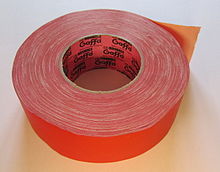Gaffer tape


Gaffer tape (also known as gaffer's tape, gaff tape or gaffa tape
While sometimes confused with duct tape, gaffer tape differs in the composition of both the backing, which is made from fabric as opposed to vinyl or other plastics, and the adhesive, which is more resistant to heat and more easily removed without damaging the surface to which it adhered.[2]
History
The precise origin of the name is unknown, one hypothesis being that it is named for the
Gaffer tape was invented in 1959 by Ross Lowell, director, cinematographer, and founder of Lowel-Light.[6] Lowell reworked Johnson & Johnson's Permacel duct tape product by combining the Permacel adhesive with a silver fabric backing to create gaffer tape which could hold a flat metal plate to a window. [7]
Properties and uses

Gaffer tape is manufactured in many

A common application for gaffer tape is securing cables to a stage floor, podium, or other surface, either for safety or concealment.
In the absence of console tape or artist tape, live sound engineers or light board operators may use a strip of white gaffer tape along the bottom of a mixing board to label the channels or submasters used for a particular show.[3]
In rock climbing gyms, gaffer tape can be used to mark climbs on the wall. It is preferable to duct tape because it is stronger and lasts longer on the wall.
See also
References
- ISBN 9781581154856
- ISSN 1554-2009.
- ^ a b "What is Gaffer's Tape?". wiseGEEK. Retrieved 22 February 2015.
- ^ Church of the Holy Gaffer Tape - Top Tips for Gaffer Tape, archived from the original on 2007-11-12, retrieved 2007-10-29
- ^ "Gaffing cable to the floor". ControlBooth. Retrieved 2016-03-09.
- ^ "About Lowel Light". lowel.tiffen.com. Archived from the original on 2019-02-26. Retrieved 2019-12-02.
- ^ "Obituary: Ross Lowell, Founder of Lowel-Light and Creator of Gaffer Tape, 92". PDNPulse. 2019-02-20. Retrieved 2019-02-21.
- PMID 12083565.
- ISSN 0007-1994.
- OCLC 879632388.
- ^ "Types Of Tape (And Not The Recording Type) For Audio/Production". www.prosoundweb.com. Retrieved 23 February 2015.
